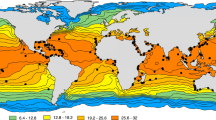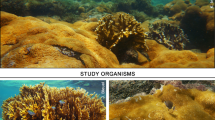Abstract
Negative interactions between corals and algae often are implicated in preventing the recovery of coral-depauperate reefs. However, few studies have explored the effects of environmental conditions on the mechanisms underlying the outcomes of coral–algal interactions. We examined the influence of water flow, a pervasive feature of reefs that is known to affect both coral and algal physiology, on massive Porites–algal interactions at different spatial and temporal scales with two types of algal competitors. Outcomes of coral–algal interactions were influenced by both water flow and algal type. Algal turfs outcompeted corals more frequently in low flow conditions, where microbial concentrations were higher, than in higher flow areas. Turbinaria ornata outcompeted massive Porites more often in higher flow and consistently was associated with lower microbial concentrations. This study highlights that outcomes of coral–algal interactions are microhabitat dependent and that water flow limits the effectiveness of some mechanisms of coral–algal competition.







Similar content being viewed by others
References
Adam TC, Schmitt RJ, Holbrook SJ, Brooks AJ, Edmunds PJ, Carpenter RC, Bernardi G (2011) Herbivory, connectivity, and ecosystem resilience: response of a coral reef to a large-scale perturbation. PLoS One 6(8):e23717
Atkinson M, Bilger R (1992) Effects of water velocity on phosphate uptake in coral reef-flat communities. Limnol Oceanogr 37:273–279
Azam F, Fenchel T, Field JG, Gray JS, Meyer-Reil LA, Thingstad F (1983) The ecological role of water-column microbes in the sea. Mar Ecol Prog Ser 10(3):257–263
Barott KL, Rohwer FL (2012) Unseen players shape benthic competition on coral reefs. Trends in Microbiol 20(12):621–628
Barott K, Smith J, Dinsdale E, Hatay M, Sandin S (2009) Hyperspectral and physiological analyses of coral-algal interactions. PLoS ONE 4:e8043
Barott KL, Rodriguez-Brito B, Janouškovec J, Marhaven K, Smith JE, Keeling P, Rohwer F (2011) Microbial diversity associated with four functional groups of benthic reef algae and the reef-building coral Montastraea annularis. Environ Microbiol 13(5):1192–1204
Barott KL, Williams GJ, Vermeij M, Harris J, Smith JE, Rohwer FL, Sandin SA (2012) Natural history of coral−algae competition across a gradient of human activity in the Line Islands. Mar Ecol Prog Ser 460:1–12
Bellwood DR, Hughes TP, Folke C, Nyström M (2004) Confronting the coral reef crisis. Nature 429:827–833
Birrell CL, McCook LJ, Willis BL (2005) Effects of algal turfs and sediment on coral settlement. Mar Pollut Bull 51:408–414
Box SJ, Mumby PJ (2007) Effect of macroalgal competition on growth and survival of juvenile Caribbean corals. Mar Ecol Prog Ser 342:139–149
Brown AL, Carpenter RC (2013) Water flow mediated oxygen dynamics within massive Porites–algal turf interactions. Mar Ecol Prog Ser 490:1–10
Carpenter RC, Williams SL (1993) Effects of algal turf canopy height and microscale substratum topography on profiles of flow speed in a coral forereef environment. Limnol Oceanogry 38(3):687–694
Carpenter R, Williams S (2007) Mass transfer limitation of photosynthesis of coral reef algal turfs. Mar Biol 151:435–450
Cole JWL, Grizzle JE (1966) Applications of multivariate analysis of variance to repeated measures experiments. Biometrics 22:810–828
Denny MW (1988) Biology and the mechanics of the wave-swept environment. Princeton University Press, Princeton
Dinsdale EA, Pantos O, Smriga S, Edwards RA, Angly F, Wegley L, Hatay M, Hall D, Brown E, Haynes M, Krause L, Sala E, Sandin SA, Thurber RV, Willis BL, Azam F, Knowlton N, Rohwer F (2008) Microbial ecology of four coral atolls in the Northern Line Islands. PLoS One 3:e1584
Doty MS (1971) Measurement of water movement in reference to benthic algal growth. Bot Mar 14(1):32–35
Ducklow HW, Mitchell R (1979) Observations on naturally and artificially diseased tropical corals: a scanning electron microscope study. Microb Ecol 5:215–223
Garren M, Azam F (2010) New method for counting bacteria associated with coral mucus. Appl Environ Microbiol 76(18):6128–6133
Garren M, Kwangmin S, Raina JB, Rusconi R, Menolascina F, Shapiro OH, Tout J, Bourne DG, Seymour JR, Stocker R (2014) A bacterial pathogen uses dimethylsulfoniopropionate as a cue to target heat-stressed corals. ISME 8:999–1007
Genin A, Karp L, Miroz A (1994) Effects of flow on competitive superiority in scleractinian corals. Limnol Oceanogr 39(4):913–924
Haas AF, Nelson CE, Wegley Kelly L, Carlson CA, Rohwer F, Leichter JJ, Wyatt A, Smith J (2011) Effects of coral reef benthic primary producers on dissolved organic carbon and microbial activity. PLoS One 6(11):e27973
Haas AF, Gregg AK, Smith JE, Abieri ML, Hatay M, Rohwer F (2013) Visualization of oxygen distribution patterns caused by coral and algae. PeerJ 1:e106
Hauri C, Fabricius KE, Schaffelke B, Humphrey C (2010) Chemical and physical environmental conditions underneath mat- and canopy-forming macroalgae, and their effects on understory corals. PLoS One 5(9):e1268
Helmuth BST, Sebens KP, Daniel TL (1997) Morphological variation in coral aggregations: branch spacing and mass flux to coral tissues. J Exp Mar Biol Ecol 209:233–259
Hench JL, Rosman JH (2013) Observations of spatial flow patterns at the coral colony scale on a shallow reef flat. J Geophys Res Oceans 118:1142–1156. doi:10.1002/jgrc.20105
Hench JL, Leichter JJ, Monismith SG (2008) Episodic circulation and exchange in a wave-driven coral reef and lagoon system. Limnol Oceanogr 53(6):2681–2694
Hughes TP (1994) Catastrophes, phase shifts, and large-scale degradation of a Caribbean coral reef. Science 265(5178):1547–1551
Jompa J, McCook LJ (2002) The effects of nutrients and herbivory on competition between a hard coral (Porites cylindrica) and a brown alga (Lobophora variegata). Limnol Oceanogr 47(2):527–534
Jompa J, McCook LJ (2003) Coral–algal competition: macroalgae with different properties have different effects on corals. Mar Ecol Prog Ser 258:87–95
Kline DI, Kuntz NM, Breitbart M, Knowlton N, Rohwer F (2006) Role of elevated organic carbon levels and microbial activity in coral mortality. Mar Ecol Prog Ser 314:119–125
Kohler KE, Gill SM (2006) Coral Point Count with Excel extensions (CPCe): a Visual Basic program for the determination of coral and substrate coverage using random point count methodology. Comput Geosci 32(9):1259–1269
Kühl M, Cohen Y, Dalsgaard T, Jørgenson BB, Revsbech NP (1995) Microenvironment and photosynthesis of zooxanthellae in scleractinian corals studied with microsensors for O2, pH and light. Mar Ecol Prog Ser 117:159–172
Lang J (1973) Interspecific aggression by scleractinian corals. 2. Why the race is not only to the swift. Bull Mar Sci 23(2):260–279
Lenihan H, Adjeroud M, Kotchen M, Hench JL, Nakamura T (2008) Reef structure regulates small-scale spatial variation in coral bleaching. Mar Ecol Prog Ser 370:127–141
Mass T, Genin A, Shavit U, Grinstein M, Tchernov D (2010) Flow enhances photosynthesis in marine benthic autotrophs by increasing the efflux of oxygen from the organism to the water. Proc Natl Acad Sci USA 107(6):2527–2531
McCook LJ (2001) Competition between corals and algal turfs along a gradient of terrestrial influence in the nearshore central Great Barrier Reef. Coral Reefs 19:419–425
McCook LJ, Jompa J, Diaz-Pulido G (2001) Competition between corals and algae on coral reefs: a review of evidence and mechanisms. Coral Reefs 19:400–417
Moberg F, Folke C (1999) Ecological goods and services of coral reef ecosystems. Ecol Econ 29:215–233
Monismith S (2007) Hydrodynamics of coral reefs. Annu Rev Fluid Mech 39:37–55. doi:10.1146/annurev.fluid.38.050304.092125
Nelson CE, Alldredge AL, McCliment EA, Amaral-Zettler LA, Carlson CA (2011) Depleted dissolved organic carbon and distinct bacterial communities in the water column of a rapid-flushing coral reef ecosystem. ISME J 5:1374–1387
Nugues MM, Smith GW, van Hooidonk RJ, Seabra MI, Bak RPM (2004) Algal contact as a trigger for coral disease. Ecol Lett 7:919–923
Patten NL, Seymour JR, Mitchell JG (2006) Flow cytometric analysis of virus-like particles and heterotrophic bacteria within coral-associated reef water. J Mar Biol Assoc UK 86:563–566
Patterson MR, Sebens KP, Olsen RR (1991) In situ measurements of flow effects on primary production and dark respiration in reef corals. Limnol Oceanogr 36(5):936–948
Quan-Young LI, Espinoza-Avalos J (2006) Reduction of zooxanthellae density, chlorophyll a concentration, and tissue thickness of the coral Montastraea faveolata (Scleractinia) when competing with mixed turf algae. Limnol Oceanogr 51(2):1159–1166
Rasher DB, Hay ME (2010) Chemically rich seaweeds poison corals when not controlled by herbivores. Proc Natl Acad Sci USA 107(21):9683–9688
Rasher DB, Stout EP, Engel S, Kubanek J, Hay ME (2011) Macroalgal terpenes function as allelopathic agents against reef corals. Proc Natl Acad Sci USA 108(43):17726–17731
Reidenbach M, Monismith S, Koseff J et al (2006) Boundary layer turbulence and flow structure over a fringing coral reef. Limnol Oceanogr 51:1956–1968
River GF, Edmunds PJ (2001) Mechanisms of interaction between macroalgae and scleractinians on a coral reef in Jamaica. J Exp Mar Biol Ecol 261:159–172
Shashar N, Kinane S, Jokiel PL, Patterson MR (1996) Hydromechanical boundary layers over a coral reef. J Exp Mar Biol Ecol 199(1):17–28
Smith JE, Shaw M, Edwards RA, Obura D, Pantos O, Sala E, Sandin SA, Smriga S, Hatay M, Rohwer FL (2006) Indirect effects of algae on coral: algae-mediated, microbe-induced coral mortality. Ecol Lett 9:835–845
Steneck RS, Dethier MN (1994) A functional group approach to the structure of algal-dominated communities. Oikos 69(3):476–498
Thompson TL, Glenn EP (1994) Plaster standards to measure water motion. Limnol Oceanogr 39(7):1768–1779
Wangpraseurt D, Weber M, Røy H, Polerecky L, De Beer D, Suharsono, Nugues MM (2012) In situ oxygen dynamics in coral-algal tnteractions. PLoS ONE 7:e31192
Acknowledgments
We would like to thank P.J. Edmunds for comments and assistance throughout this project. Thanks to C. Nelson for assistance with microbial aspects, specifically flow cytometry. Thanks to V.W. Moriarty, M.D. Johnson, S.A. Swanson, and J.C. Gowan for laboratory and field assistance. Thanks as well to the Gump Field Station for their support. The project was funded under the MCR LTER OCE 04-17412/OCE 10-26851 Grant, the Gordon and Betty Moore Foundation and California State University, Northridge. This is Contribution No. 226 from the CSUN Marine Biology Program.
Author information
Authors and Affiliations
Corresponding author
Additional information
Communicated by F. Bulleri.
Rights and permissions
About this article
Cite this article
Brown, A.L., Carpenter, R.C. Water flow influences the mechanisms and outcomes of interactions between massive Porites and coral reef algae. Mar Biol 162, 459–468 (2015). https://doi.org/10.1007/s00227-014-2593-5
Received:
Accepted:
Published:
Issue Date:
DOI: https://doi.org/10.1007/s00227-014-2593-5




